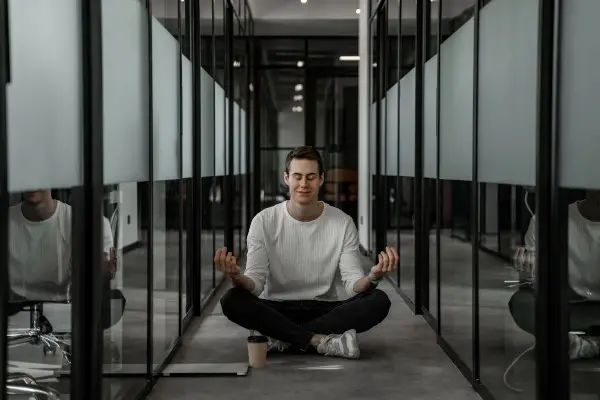Meditation is a transformative practice, but it often comes with misconceptions that may discourage individuals from starting or continuing their journey. In this article, we debunk ten common myths surrounding meditation, offering clarity and encouragement for those curious about or already engaged in this practice. From understanding that you don’t need to clear your mind completely to discovering that meditation isn’t just for spiritual people, we’ll debunk these misconceptions together.
So, let’s uncover the real essence of meditation and find out how it can bring calmness and focus to your life.
Myth: Meditation requires clearing the mind completely.
When it comes to meditation, a common misconception is that you need to empty your mind entirely. However, this belief can create unnecessary pressure and frustration for beginners.
In reality, meditation isn’t about forcefully clearing the mind of all thoughts. Instead, it involves observing thoughts as they arise without getting caught up in them. It’s like sitting by a riverbank and watching the stream of thoughts flow by without trying to stop or control them.
Just as waves rise and fall in the ocean, thoughts naturally come and go during meditation. It’s normal to experience moments of stillness as well as periods of increased mental activity. Rather than resisting these fluctuations, meditation teaches us to embrace them as part of the journey.
Study: A study published in “Psychological Science” found that mindfulness meditation does not require clearing the mind of thoughts but instead involves observing thoughts non-judgmentally. (Reference: Zeidan, F., Johnson, S. K., Diamond, B. J., David, Z., & Goolkasian, P. (2010). Mindfulness meditation improves cognition: Evidence of brief mental training. Psychological Science, 21(10), 1411–1417.)
Myth: Meditation is only for spiritual or religious individuals.
Many people associate meditation exclusively with spirituality or religion, assuming it’s only for those on a specific spiritual path. However, this belief overlooks the diverse and inclusive nature of meditation practices.
While meditation does have roots in various spiritual traditions, numerous secular approaches have emerged, making it accessible to people of all backgrounds. These secular practices focus on the mental and physical benefits of meditation, independent of any religious context.
Furthermore, meditation can be tailored to align with individual beliefs or philosophies. Whether one follows a particular spiritual tradition, identifies as agnostic, or holds secular humanist views, meditation can be adapted to complement and enrich personal beliefs.
Study: Research published in “JAMA Internal Medicine” suggests that mindfulness meditation, even when stripped of religious or spiritual context, can have significant benefits for mental health and well-being. (Reference: Goyal, M., Singh, S., Sibinga, E. M., Gould, N. F., Rowland-Seymour, A., Sharma, R., … & Haythornthwaite, J. A. (2014). Meditation programs for psychological stress and well-being: A systematic review and meta-analysis. JAMA Internal Medicine, 174(3), 357-368.)

Myth: Meditation is time-consuming and impractical
Some individuals believe that meditation requires lengthy sessions, making it impractical for busy schedules. However, this myth overlooks the effectiveness of short, focused meditation practices and the flexibility to integrate them into daily life.
Contrary to popular belief, meditation doesn’t always require hours of dedication. Short, focused meditation sessions can be highly effective in cultivating mindfulness and reducing stress. Even just a few minutes of practice each day can yield noticeable benefits over time.
For those with hectic schedules, integrating meditation into daily routines can make it more accessible and sustainable. Simple strategies include meditating during short breaks throughout the day, incorporating mindfulness into everyday activities like walking or eating, or dedicating a specific time each day for meditation practice.
Study: A study published in “Frontiers in Human Neuroscience” found that brief meditation sessions as short as 10 minutes can significantly reduce stress and improve cognitive function. (Reference: Tang, Y. Y., Ma, Y., Fan, Y., Feng, H., Wang, J., Feng, S., … & Posner, M. I. (2009). Central and autonomic nervous system interaction is altered by short-term meditation. Proceedings of the National Academy of Sciences, 106(22), 8865-8870.)
Myth: You must sit cross-legged for meditation to be effective.
There’s a common misconception that the only way to meditate effectively is by sitting cross-legged on the floor. However, this belief ignores the fact that meditation can be practiced in various comfortable positions, accommodating individual preferences and physical abilities.
Contrary to popular belief, there isn’t a one-size-fits-all posture for meditation. While sitting cross-legged works well for some individuals, others may find it uncomfortable or impractical. The key is to find a posture that allows for relaxation and attentiveness without strain or discomfort.
Fortunately, numerous alternative positions for meditation can be equally effective. These include sitting on a chair with feet flat on the floor, kneeling with a cushion for support, or even lying down if sitting upright is challenging. The goal is to find a position that promotes relaxation and attentiveness while minimizing distractions.
Study: Research published in “Psychosomatic Medicine” suggests that individuals can achieve similar benefits from meditation whether sitting in a traditional cross-legged posture or in a chair. (Reference: Lutz, A., Greischar, L. L., Rawlings, N. B., Ricard, M., & Davidson, R. J. (2004). Long-term meditators self-induce high-amplitude gamma synchrony during mental practice. Proceedings of the National Academy of Sciences, 101(46), 16369-16373.)

Myth: Meditation is about escaping reality.
Some people perceive meditation as a means of escaping reality, disconnecting from the present moment to seek solace elsewhere. However, this perspective misunderstands the essence of meditation, which is rooted in being fully present and engaged with reality.
Rather than an escape, meditation is a practice of deepening awareness and acceptance of the present moment. It encourages individuals to cultivate a mindful presence, acknowledging thoughts, emotions, and sensations without judgment or resistance. In essence, meditation is about embracing reality as it is, rather than seeking to evade it.
The Role of Mindfulness
Mindfulness, a key component of meditation, enhances our ability to navigate challenges in daily life. By cultivating mindfulness, individuals develop greater clarity, resilience, and emotional regulation, enabling them to respond to life’s ups and downs with greater ease and equanimity. Rather than escaping reality, meditation equips us with the tools to engage with it more skillfully.
Study: Research published in “Psychiatry Research” indicates that mindfulness meditation is associated with increased gray matter density in brain regions involved in self-awareness and emotion regulation, suggesting a greater capacity to engage with reality rather than escape from it. (Reference: Hölzel, B. K., Carmody, J., Vangel, M., Congleton, C., Yerramsetti, S. M., Gard, T., & Lazar, S. W. (2011). Mindfulness practice leads to increases in regional brain gray matter density. Psychiatry Research: Neuroimaging, 191(1), 36-43.)
Related reading: Freeing Your Mind: 5 Cultural and Religious Misconceptions about Meditation – Opens in new tab
Myth: Constant thoughts mean meditation isn’t working.
It’s a common misconception that if your mind is constantly buzzing with thoughts during meditation, you’re not doing it right. However, this belief overlooks an important aspect of meditation practice and can lead to unnecessary frustration.
In reality, the presence of thoughts during meditation is entirely normal and doesn’t indicate failure or lack of progress. The mind naturally generates thoughts, and it’s not possible to completely stop them. Instead of striving to eliminate thoughts, the goal of meditation is to observe them without becoming entangled or carried away by them.
Being aware of the constant stream of thoughts is actually a sign of a mindful meditation practice. It demonstrates an increased level of self-awareness and the ability to observe the fluctuations of the mind without getting caught up in them. Rather than trying to suppress thoughts, meditation teaches us to acknowledge them with kindness and curiosity.
Study: A study published in “Psychological Bulletin” suggests that the effectiveness of meditation is not determined by the absence of thoughts but rather by the practitioner’s ability to observe thoughts without becoming entangled in them. (Reference: Eberth, J., & Sedlmeier, P. (2012). The effects of mindfulness meditation: A meta-analysis. Psychological Bulletin, 138(6), 1139–1171.)

Myth: Clearing the mind leads to immediate peace.
There’s a misconception that the ultimate goal of meditation is to achieve immediate peace by completely clearing the mind of all thoughts. However, this belief overlooks the true source of peace in meditation and can set unrealistic expectations for practitioners.
True peace in meditation stems from accepting the present moment exactly as it is, rather than striving to attain a state of mental emptiness. It’s about cultivating an attitude of openness and non-judgment toward whatever arises, whether it’s thoughts, emotions, or sensations.
Instead of fixating on the idea of achieving a perfectly clear mind, practitioners are encouraged to embrace the journey of meditation itself. This means recognizing that the path to inner peace is not always linear and that there will inevitably be moments of challenge and distraction along the way. By embracing the journey with patience and compassion, practitioners can cultivate a deeper sense of peace and contentment in the present moment.
Study: Research published in “Frontiers in Psychology” indicates that peace experienced during meditation arises from acceptance and non-resistance to the present moment rather than from attempting to forcibly clear the mind. (Reference: Cahn, B. R., & Polich, J. (2006). Meditation states and traits: EEG, ERP, and neuroimaging studies. Psychological Bulletin, 132(2), 180–211.)
Myth: Progress in meditation is measured only by time spent.
There’s a common misconception that the primary measure of progress in meditation is the amount of time spent in practice. However, this belief overlooks the importance of the quality of meditation and can lead practitioners to prioritize quantity over depth.
Rather than focusing solely on the quantity of time spent meditating, it’s essential to prioritize the quality of each meditation session. A brief, focused practice with deep presence and awareness can be more transformative than a longer session filled with distractions and mental chatter.
Consistency and presence are key factors in meditation progress, regardless of the duration of each session. Regular, dedicated practice builds momentum and allows practitioners to deepen their understanding and experience of meditation over time. By cultivating presence and attentiveness in each moment of practice, individuals can tap into the transformative power of meditation, regardless of the length of time spent.
Study: A study published in “Behavior Research and Therapy” suggests that the quality of meditation practice, characterized by factors such as attentiveness and non-reactivity, is more closely related to positive outcomes than the duration of each session. (Reference: Sauer-Zavala, S., Walsh, E. C., Eisenlohr-Moul, T. A., & Lykins, E. L. (2013). Comparing mindfulness-based intervention strategies: Differential effects of sitting meditation, body scan, and mindful yoga. Behavior Research and Therapy, 51(7), 401-408.)

Myth: There’s only one “right” way to meditate.
Many people believe that there’s a single, universally correct method of meditation that everyone should follow. However, this belief fails to acknowledge the diversity of meditation practices and the importance of finding an approach that aligns with individual preferences and needs.
In reality, there are countless meditation techniques, each with its own unique focus and approach. From mindfulness meditation to loving-kindness meditation, transcendental meditation to breath awareness, the options are vast and varied. Recognizing this diversity allows individuals to explore different techniques and discover what resonates most with them.
Rather than adhering rigidly to a prescribed method of meditation, practitioners are encouraged to experiment and explore different techniques. By trying out various approaches, individuals can find the one that feels most comfortable and effective for them. This might involve attending different meditation classes, exploring guided meditation apps, or simply experimenting with different techniques at home.
Study: Research published in “Complementary Therapies in Medicine” suggests that various meditation techniques, such as focused attention, loving-kindness, and body scan meditation, can produce similar benefits, indicating that there isn’t a singular correct approach to meditation. (Reference: Van Dam, N. T., van Vugt, M. K., Vago, D. R., Schmalzl, L., Saron, C. D., Olendzki, A., … & Fox, K. C. (2018). Mind the hype: A critical evaluation and prescriptive agenda for research on mindfulness and meditation. Perspectives on Psychological Science, 13(1), 36-61.)
Myth: Meditation requires complete silence and solitude.
It’s a common belief that meditation necessitates a quiet, solitary environment free from distractions. However, this misconception overlooks the versatility of meditation practices and the potential for mindfulness in any setting.
Meditation can be practiced in a wide range of environments, including noisy or busy ones. While a serene setting can certainly enhance the meditation experience, it’s not a requirement for cultivating mindfulness and inner peace. In fact, practicing meditation in diverse environments can help strengthen one’s ability to maintain focus and presence amidst external distractions.
Techniques for Maintaining Focus
In noisy or busy environments, maintaining focus and mindfulness can be challenging but not impossible. Techniques such as focusing on the breath, anchoring awareness in the present moment, or using sound as a meditation object can help practitioners stay centered amidst external stimuli. Additionally, cultivating a non-judgmental attitude toward distractions can foster greater resilience and adaptability in meditation practice.
Integration into Daily Activities
Beyond formal meditation sessions, mindfulness can be integrated into daily activities as well. Practices like walking meditation, mindful eating, or even mindful listening can enhance awareness and presence in everyday life. By embracing mindfulness in various contexts, individuals can cultivate a deeper sense of connection with themselves and the world around them.
Study: A study published in “Mindfulness” found that individuals can maintain mindfulness and focus during meditation even in noisy environments by using techniques such as anchoring attention to the breath or body sensations. (Reference: Travis, F., & Shear, J. (2010). Focused attention, open monitoring and automatic self-transcending: Categories to organize meditations from Vedic, Buddhist and Chinese traditions. Consciousness and Cognition, 19(4), 1110-1118.)
End Words
As we conclude our exploration of the myths surrounding meditation, it’s clear that this ancient practice offers boundless possibilities for personal growth and inner harmony. By dispelling misconceptions and embracing the truth, individuals can approach meditation with confidence, knowing that it’s a flexible, accessible tool for cultivating mindfulness and resilience in daily life. Let’s continue to challenge assumptions and embrace the transformative potential of meditation on our journey toward greater well-being.
Do you want to learn more about Meditation? Check out our recommendations at “Meditation Bookshelf” and many free resources at our “Free MeditationLibrary“ – Opens in new tab
Stay in Touch
 Join our newsletter by using the forms on this website or click here!
Join our newsletter by using the forms on this website or click here! Follow us on Google News
Follow us on Google News Follow us on Facebook
Follow us on Facebook
Featured image from Depositphotos






